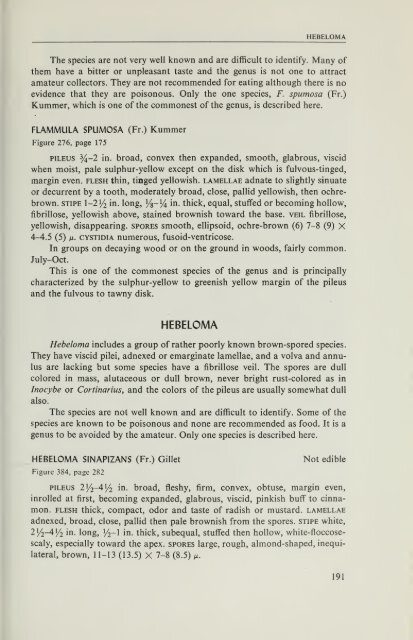Create successful ePaper yourself
Turn your PDF publications into a flip-book with our unique Google optimized e-Paper software.
HEBELOMA<br />
The Species are not very well known and are difficult to identify. Many of<br />
them have a bitter or unpleasant taste and the genus is not one to attract<br />
amateur collectors. They are not recommended for eating although there is no<br />
evidence that they are poisonous. Only the one species, F. spumosa (Fr.)<br />
Kummer, which is one of the commonest of the genus, is described here.<br />
FLAMMULA SPUMOSA (Fr.) Kummer<br />
Figure 276, page 175<br />
piLEus %-2 in. broad, convex then expanded, smooth, glabrous, viscid<br />
when moist, pale sulphur-yellow except on the disk which is fulvous-tinged,<br />
margin even, flesh thin, tinged yellowish, lamellae adnate to shghtly sinuate<br />
or decurrent by a tooth, moderately broad, close, pallid yellowish, then ochre-<br />
brown. STIPE 1-21/2 in. long, V8-!4 in. thick, equal, stuffed or becoming hollow,<br />
fibrillose, yellowish above, stained brownish toward the base, veil fibrillose,<br />
yellowish, disappearing, spores smooth, ellipsoid, ochre-brown (6) 7-8 (9) X<br />
4-4.5 (5) M- CYSTiDiA numerous, fusoid-ventricose.<br />
In groups on decaying wood or on the ground in woods, fairly common.<br />
July-Oct.<br />
This is one of the commonest species of the genus and is principally<br />
characterized by the sulphur-yellow to greenish yellow margin of the pileus<br />
and the fulvous to tawny disk.<br />
HEBELOMA<br />
Hebeloma includes a group of rather poorly known brown-spored species.<br />
They have viscid pilei, adnexed or emarginate lamellae, and a volva and annu-<br />
lus are lacking but some species have a fibrillose veil. The spores are dull<br />
colored in mass, alutaceous or dull brown, never bright rust-colored as in<br />
Inocybe or Cortinarius, and the colors of the pileus are usually somewhat dull<br />
also.<br />
The species are not well known and are difficult to identify. Some of the<br />
species are known to be poisonous and none are recommended as food. It is a<br />
genus to be avoided by the amateur. Only one species is described here.<br />
HEBELOMA SINAPIZANS (Fr.) Gillet Not edible<br />
Figure 384, page 282<br />
PILEUS 21/2-4J/2 in. broad, fleshy, firm, convex, obtuse, margin even,<br />
inrolled at first, becoming expanded, glabrous, viscid, pinkish buff" to cinnamon.<br />
FLESH thick, compact, odor and taste of radish or mustard, lamellae<br />
adnexed, broad, close, pallid then pale brownish from the spores, stipe white,<br />
'^Vi-^Vi in. long, 1/2-1 in. thick, subequal, stuff'ed then hollow, white-floccosescaly,<br />
especially toward the apex, spores large, rough, almond-shaped, inequi-<br />
lateral, brown, 11-13 (13.5) X 7-8 (8.5) m-<br />
191

















